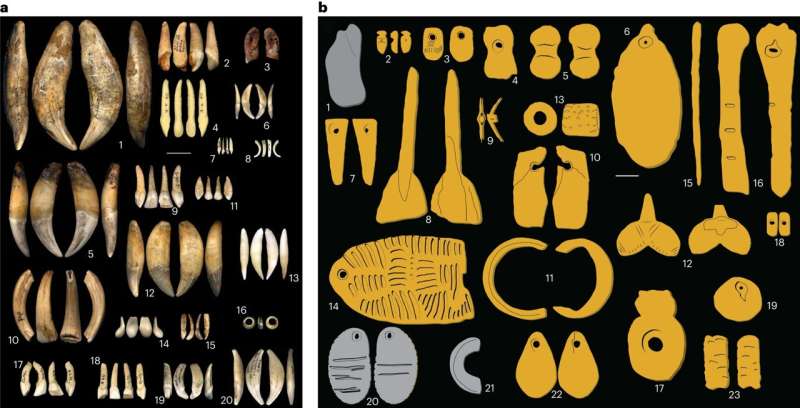January 30, 2024 report
This article has been reviewed according to Science X's editorial process and policies. Editors have highlighted the following attributes while ensuring the content's credibility:
fact-checked
peer-reviewed publication
trusted source
proofread
Study of ancient adornments suggests nine distinct cultures lived in Europe during the Paleolithic

A team of anthropologists at Université Bordeaux has found evidence of nine distinct cultures living in what is now Europe during the Gravettian period. In their study, reported in the journal Nature Human Behavior, the group analyzed personal adornments worn by people living in the region between 24,000 and 34,000 years ago. Reuven Yeshurun, with the University of Haifa, has published a News & Views piece in the same journal issue, outlining the work done by the team.
Prior research has shown that humans have been adorning themselves for thousands of years. In this new effort, the researchers looked at the types of adornments that were worn by people living in Europe during the Gravettian period—a time during the Paleolithic when a culture known as the Gravettian populated the region.
During this time, people were still hunter–gatherers and dressed themselves in animal skins. They also collected objects to use for adorning themselves, either by attachment to their clothes, their limbs or to their skin. Such objects included animal teeth, bones, ivory, rocks, shells, amber and wood. Some objects were attached or worn as they were, while others were carved or had holes that allowed for attachment via thread.
The researchers looked into the possibility of identifying distinct subcultures among the people living in Europe during the Gravettian period by identifying unique characteristics of their adornments. To that end, they obtained hundreds of such ornamentations and analyzed them to look for patterns.
They found what they describe as consistent differences between groups living in different areas. They found, for example, that people living in what is now Eastern Europe tended to prefer white objects, such as ivory and teeth, whereas those people living on the other side of the Alps tended to gravitate toward more vibrantly colored objects, such as stones and shells. The differences, the team claims, were striking, and strong enough to allow for the identification of nine distinct cultural groups.
More information: Jack Baker et al, Evidence from personal ornaments suggest nine distinct cultural groups between 34,000 and 24,000 years ago in Europe, Nature Human Behaviour (2024). DOI: 10.1038/s41562-023-01803-6
Reuven Yeshurun, Signalling Palaeolithic identity, Nature Human Behaviour (2024). DOI: 10.1038/s41562-023-01805-4
Journal information: Nature Human Behaviour
© 2024 Science X Network




















